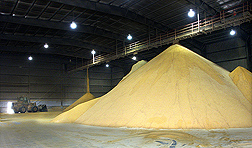| 
Tons of distiller's dried grains being held in
storage at an ethanol plant. Click the image for more information about
it.
|
|

|
Ethanol Byproducts Pelletized
By Don Comis
June 25, 2007 One hundred percent of distiller's
dried grains with solubles (DDGS), a byproduct of ethanol production, can be
pelletized without adding a binding agent or anything else, according to
Agricultural Research Service (ARS)
scientists and cooperators.
ARS agricultural engineeer
Kurt
Rosentrater has turned DDGS from corn-based ethanol production into
high-quality pellets using processing equipment at a commercial feed mill. And
the heating used in pelletizing did not harm the high-protein, low-starch
nutrient content. Rosentrater is at the ARS
North
Central Agricultural Research Laboratory, Brookings, S.D. He does this
research with colleagues at ARS and at nearby
South Dakota State University.
Cattle feed is currently the primary outlet for distiller's grain. But other
livestock such as swine and poultry can also eat it. To date, there are no
commercial DDGS pellets available for livestock, which limits the
byproduct’s use in rangeland settings. DDGS is the protein, fat, fiber,
unconverted starch and ash left over after ethanol production.
Fish raised for food in the growing aquaculture industry eat pelletized
feed, but those pellets contain commercial fish meal as a protein source, not
the less-expensive distiller's grain. Rosentrater is experimenting with adding
soy and corn flour to distiller's grain to produce pelletized feeds, to see how
far he can reduce the fish meal—or if he can eliminate it entirely.
This pelletizing work also promises to solve a growing problem of product
deterioration—as well as hardening and caking problems during shipping and
storage, which can clog the various chutes and bins that DDGS flows through.
With an increasing supply of the byproduct, ethanol plants have to ship it
greater distances to reach markets.
South Dakota, one of the country's biggest ethanol-producing states, expects
to produce a billion gallons of ethanol to fuel vehicles next year—about
the entire nation's production in 1999. Today, nationwide ethanol production is
more than five billion gallons a year, and that amount will increase as new
plants come online.
Ethanol plants are spreading outside of the Corn Belt, with plants now in
New York and California, for example.
ARS is the U.S. Department of
Agriculture's chief scientific research agency.